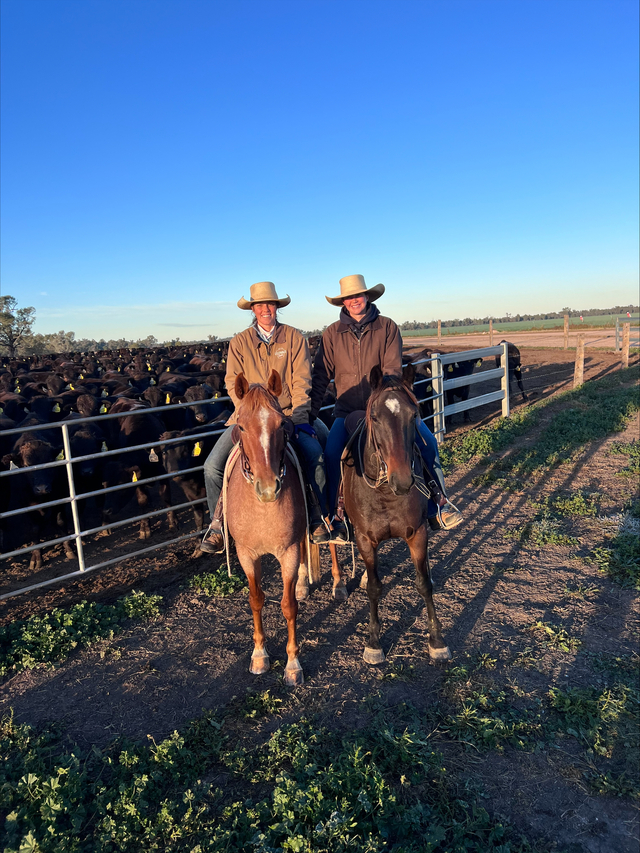Condamine sisters Claire and Hannah Morgan relied on the equestrian experience gained on their family farm Arubial to help them conquer the Mongol Derby, the world’s longest and toughest horse race.
On 7 August, both embarked on a 10-day ride, spending 12 hours a day in the saddle across 1000 kilometres of Mongolia’s vast, isolated wilderness.
“It was a once in a lifetime experience,“ said Claire.
“Being able to travel while doing something in the realm of what we’ve grown up with here at home with horses and pushing ourselves to our personal limits – and doing it together – just added to the experience.
“We understood and appreciated that, no matter how prepared we were, it was going to be difficult. We were taken out of our comfort zones.
“But, it was such a cool thing that we are really grateful to be a part of.“
For Claire and Hannah, participating in the Mongol Derby was the culmination of a lifelong passion for equestrianism. Growing up on their family property mustering and campdrafting, they relished the chanced to take their horsemanship to the next level.
Training for the derby involved riding 40 to 80km daily to build endurance but, as Claire said, the biggest challenge was actually squeezing 10 days of essentials under the five kilogram weight limit.
“From clothes to sleeping bags, emergency/ medical kits, small gifts for the herding families, protein bars and electrolytes, it has been a challenge in itself fitting all that in under five kilograms,“ she said.
“I literally sat with the kitchen scales measuring each item one by one.
“We opted not to take an inflatable pillow because it weighed 82 grams and that could be allocated elsewhere.
“I also snapped the handle off my hair brush because that weighed 30 grams. My phone was 232 grams but that came to take photos!“
The Morgan sisters first encountered the Mongol Derby when a family friend completed the trek in 2019. Rather than intimidate them, the race inspired them.
“We were on a flight to Western Australia for a holiday with our cousin Maddie when we wrote and submitted our application,“ Hannah said.
“It was something that certainly had our ears pricked when we heard about it back in 2019.
“And, riding the momentum of the trip to WA, we thought ‘why not tick another adventure off the bucket list’?“
Claire and Hannah applied to The Equestrianists, the organisation that hosts the Mongol Derby, then crossed their fingers. They were confident they had the experience, determination – and sense of adventure – to be seriously considered.
After a year of waiting and interviews by the Equestrianists, both were among the 45 riders selected to participate in the 2024 Mongol Derby from about 400 applicants.
“Our interview process was staggered and we both got accepted at different times,“ Hannah said.
“We were stoked to find out we were going to be tackling the race together.
“The interview process is a few rounds and you are required to supply videos and photos of you riding so they know you’re a competent and capable rider because it [the race] will certainly test your abilities and your horsemanship skills.“
The Mongol Derby
The Mongol Derby follows the postal route established by Genghis Khan across the Mongolian Steppe in 1224. Horse messengers used the route so the leader of the Mongol Empire could communicate with the far-flung corners of his conquests.
The first Mongol Derby took place in 2009 and has been held annually since then.
Today, the Mongol Derby holds the record for the longest multi-horse race in the world. Participants ride “semi-wild“ Mongolian horses between roughly 30 stations along the 1000km route, switching horses at each station.
“It requires horsemanship and it requires endurance,“ Claire said.
You GPS your way across the unmarked route so you need to be careful not to misjudge a checkpoint or get lost.
“If you decide to camp overnight between stations to gain a time advantage, it’s up to you to look after your horse and yourself overnight wherever you are.”
Riders can only ride up to 12 hours daily and can be penalised if they’ve pushed their horses too hard. Medics and equine vets are waiting at each station, along with food and water for the riders and their horses.
The Mongol Derby is notoriously treacherous and riders have been lost and injured during the race, sometimes to the point that they can’t continue. Simply finishing the derby is worth celebrating.
“It definitely is a race, like there is a first place and second place,“ Claire said.
“But, at the end of the day, they really encourage us to treat it like it the incredible adventure it is.
“Sportsmanship is also a core value of the event, so it’s not so competitive to the point where you see another rider in trouble and continue riding.
“Also, you stop at a horse station to change horses roughly every 30km. Each of those horse stations is hosted by one of the families on the Steppe so it’s important to show your appreciation to them by having a chat and giving a small gift.“
The Derby also presents an opportunity to rally support for causes the riders care about.
Alongside fundraising for Angel Flight and TIACS locally, Hannah and Claire are raising money for Steppe and Hoof (steppeandhoof.org), a native horse preservation and veterinary education program in Mongolia.
Steppe and Hoof teaches herders basic animal wound cleaning techniques and gives them the tools and knowledge of modern veterinary medicine and animal practices.
How long does the Mongol Derby take?
For 10 days each August, the Mongol Derby recreates the legendary system, building a network of 30 horse stations at 30km intervals along the entire thousand kilometre course. Riders typically ride three horses per day, or 30 horses over the entire race. At each horse station, every horse is checked by the Mongol Derby vet team to ensure horses are in good health and physical condition. Horses are checked for soundness, heart rate recovery and any signs of stress. Vets may issue a time penalty to a rider whose horse does not pass the mandatory vet check.
Rules of the Longest Horse Race in The World
* Each rider has an overall weight limit of 85kg (dressed to ride).
* Each rider is allowed to bring 5kg in personal gear in backpack (excluding water).
* Each rider is issued a custom race saddle, bridle and blanket.
* Race hours are from 7am to 7pm.







